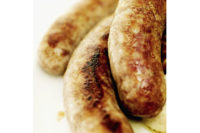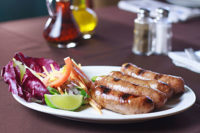The chameleon-like attributes of poultry — healthy and affordable at retail and able to carry a spicy punch at restaurants — continue to serve it well.
As restaurant brands such as Panda Express continue to enter the frozen poultry aisle, poultry’s unique combination of taste and price continues unabated. This year, fresh meat dollar sales of chicken were up 7.7 percent (ending Oct. 27, 2013), while in comparison, beef sales were up 2.1 percent, pork was up 2.1 percent and turkey was up 2.9 percent combined, according to FreshLook Marketing data, said Tom Super, vice president of communications, National Chicken Council.
Sales were up despite the fact that supermarket features for chicken decreased 4.4 percent over the same time period. And the average price for retail fresh chicken increased 6.2 percent.
“Demand is strong,” says Super. “Chicken’s nutritional value, affordability, versatility, convenience and taste can all be attributed for its ongoing strength.”
Chicago-based Mintel Group expects sales to keep increasing, from $32.8 billion in 2013 to $39.9 billion in 2018. Indeed, its “Poultry - US - November 2013” report stated that U.S. poultry sales increased 22 percent from 2008 to 2013 alone. The minimal sales growth of 2010 and 2011 (caused by high prices) was replaced in 2012 and 2013 with strong sales, most likely due to lower prices from increased production and increased interest in lean protein. Furthermore, 2013 sales were up 7.3 percent from the previous year.
At retail, consumers have shown a continued broader acceptance of the dark-meat cuts, particularly boneless, skinless thigh meat, which continues to do well.
“There also has been an increased number of chicken sausages coming onto the market,” says Super.
Consumers are certainly more interested in healthy options. According to Mintel’s report, consumers think poultry is a leaner and cheaper protein source than red meat. In addition, 88 percent said poultry is a nice choice when they don’t want to eat red meat, 85 percent say it’s easy to include in dishes, and 79 percent said freezing poultry to use later is helpful in saving them money. So resealable packaging or pre-portioned servings continue to meet consumers’ request to freeze or save poultry for other meals, the report noted.
The past year has seen an increased number of restaurant chains putting their name on chicken meals in the frozen section, says Super.
“This trend should continue as consumers seek restaurant quality and styles to serve their families,” he says. P.F. Chang’s, Panda Express, Boston Market and TGI Fridays were some of the foodservice operators to make their presence known in the frozen aisle with chicken meals.
In 2006, per capita consumption of chicken reached a record high of 87.7 pounds, says Super, before the corn-based ethanol business had its heyday.
“Since then, consumption has varied from a low of 81.0 pounds in 2009 to a high of 86.4 pounds in 2007,” he says. “In 2013, USDA’s estimated consumption is 83.2 pounds per person, 1.4 pounds more than in 2012.”
In 2014, USDA sees chicken consumption increasing 1.8 pounds over 2013 to reach 85.0 pounds per person, says Super.
“That forecast is based on the expectation of a 2.9 percent increase in production and an increase of 2.0 percent in exports,” says Super. “Since changes in consumption essentially move in lockstep with changes in production, it is quite possible to see consumption in 2014 exceed USDA’s year-end forecast.”
Turkey moves beyond holidays
Turkey consumption has nearly doubled over the past 30 years to where each person consumes 16 pounds of turkey meat over a year.
“Consumers are recognizing the health benefits of turkey as a low-fat, high-protein source, with a delicate flavor that allows seasoning to taste and cooking versatility, says Keith Williams, vice president of communications and marketing, National Turkey Federation. “While the holiday whole turkey and the all-American turkey sandwich will always have a special place in consumers’ hearts, Americans are enjoying an ever-widening variety of turkey products throughout the year.”
Ground turkey has experienced the largest sales growth among consumers in the last decade. The top three turkey product sales are whole birds, ground turkey and cooked white meat (deli meat), says Williams. Deli accounts for about 6.2 percent of turkey meat (growing from 4.3 percent in 2005).
“Pre-sliced turkey deli meats are available in numerous cuts and flavors, including turkey ham, turkey bologna and turkey salami,” he says. “Variety packs and specialized flavorings, such as honey-glazed and hickory-smoked, further expand the versatility of turkey deli meats in foodservice establishments.”
The most popular turkey product continues to be the whole turkey, comprising less than a quarter of all sales, says Williams.
“However, many turkey products are tailor-made for today’s consumers who live fast-paced lifestyles and who demand products that taste great, are healthful and easy to prepare,” he says. “As a result, several other turkey products are closing in on the whole bird’s dominance in the marketplace.”
Breakfast offerings — turkey bacon, turkey sausage and turkey links, for example — are pre-cooked and ready for skillet or microwave heating.
“Raw products, especially breast cuts, such as tenderloins and cutlets, also are seeing an increase in sales,” says Williams. The Southern tradition of deep-frying turkeys has also gained in popularity in the last few years.
“This process seals the outside while the interior remains very juicy and the skin develops a crisp texture,” he says.
Grilling turkey also has grown more convenient today with turkey tenderloins, steaks, boneless breasts and drumsticks readily available. And domesticated turkeys are bred to have white feathers, have more breast meat and meatier thighs.
“A well-treated turkey will grow to its full potential and provide consumers with a low-fat and high-protein source of nourishment,” says Williams.
Poultry adds flavor to menus
Poultry has been holding steady on restaurant menus. For a big category, any growth is significant — and chicken, for one, keeps steadily increasing and holding its ground.
“Overall, the category is pretty stable, not growing gangbusters, but one to two percent,” says Joseph Pawlak, senior vice president, Technomic. Poultry has been able to take more risks at foodservice, with new flavors and varieties of wings, boneless wings and tenderloins.
“Flavors are driving poultry today,” says Pawlak. “There aren’t new forms or formats for poultry, but foodservice operators are taking typical products in the marketplace and adding new flavors and spices to them.”
Buffalo spices are still very strong for wings, yet so are flavors such as teriyaki, honey mustard, glazes, jerk, Cajun and chipotle. Some restaurants typically offer Asian, honey, Memphis and North Carolina barbecue sauces too.
Healthy choices are still popular at restaurants, as lighter breading and whole-wheat breading continue to pop up on menus, says Pawlak.
“We’re seeing more operators grill and bake their dishes to move away from frying, although fried chicken is still popular at typical restaurants,” he says. “At colleges, schools and business cafeterias, we see more nutritious profiles for poultry.”
To that end, restaurant diners are more interested in cleaner descriptions of their poultry choices (less preservatives and additives), and they presume whole-muscle products offer that, says Pawlak.
“Organic and hormone-free are more popular but still a small portion of the menu,” he says. Chicken usually offers a better price point than steak, but Pawlak doesn’t see that as being a competitive asset on a regular restaurant menu.
However at places that rotate their menus, such as school and hospitals, lower prices will cause more poultry items to pop up on menus.
Poultry Plant of the Future update
Re-envisioning today’s poultry production and processing, a system that has evolved over the course of half a century, is clearly a long-term strategic initiative. It will require the benchmarking of existing processes as well asthe development of a framework within which to evaluate and test new ideas and concepts. Discussions are continuing between researchers and industry specialists about ideas for collaborations that will accomplish these goals. A couple of small research projects are underway — the results of which we hope will help to lay the foundation for larger, multi-university and interdisciplinary efforts. Regardless, the success of this initiative will hinge on our collective ability to create environments that foster curiosity, collaboration and innovation. We certainly hope you will join us in this endeavor, as we seek to lay the foundation for a resilient future for poultry.
Duck destiny?
According to New York-based Nielsen Co.’s “Consumers are seeking health, adventure in the meat aisle” from December 2013, consumers are showing more interested in exotic meats, such as duck, buffalo, venison and various offals or organ meats, due to a desire for health, culture and adventure.
These meats combined grew about 6 percent and achieved $350 million in sales, in the year ended June 29, 2012. And they could continue to grow if retailers invest in learning more about their shopper demographics.
For example, a recent Nielsen study showed that couples and families with healthy lifestyles, natural/organic households and affluence, tended to be the biggest purchasers of duck — and incidentally, they prefer whole ducks.
It is purchased equally across all regions, but most sales of duck occur in the first and fourth quarters of the year — during the Chinese New Year and Christmas holidays.
Cultural diversity is certainly leading to greater duck and chicken fat sales during the first quarter, and year round for chicken feet that are eaten in many Asian dishes and snacks.












Report Abusive Comment